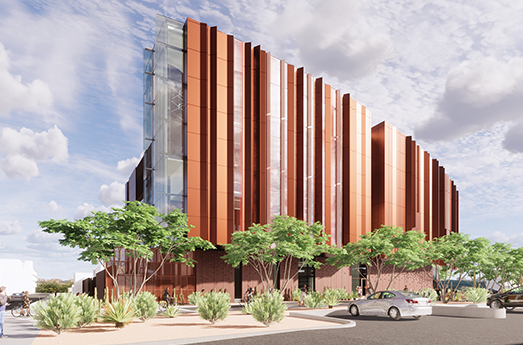
World-Class Research for Real-World Needs
By David Pittman
Construction of an $85 million, three-story building is underway at the University of Arizona that will house state-of-the-art equipment and technology to advance research in science and engineering and improve connectivity by bringing various programs at the university into a single location.
Groundbreaking for the 80,000-square-foot Applied Research Building at the southeast corner of East Helen Street and North Highland Avenue took place June 29. The structure is expected to be completed in January 2023.
“The co-location of multiple, interrelated research programs will create a hub that enables new opportunities for Fourth Industrial Revolution research that will help the university recruit and retain recognized faculty, as well as increase federal and industry funding,” said UArizona President Dr. Robert C. Robbins. “The ARB will focus on expanding several areas of research that have resulted in the university being ranked among the top 100 research institutions in the world.”
The facility will connect faculty across many distinct scientific endeavors such as healthcare, aviation, aerospace, material science, optics, astronomy and mechanical, electrical, computer and industrial engineering. Although no classes will be taught in the ARB, students can access the building’s facilities to conduct undergraduate and graduate research.
“The ARB represents a truly remarkable physical space for the university’s applied research programs to flourish and accelerate,” said Elizabeth “Betsy” Cantwell, UArizona’s SVP for research and innovation. “Beyond attracting and reinforcing our industry partners – including companies such as Raytheon, Honeywell and Lockheed Martin – research conducted in the ARB will translate into major societal impacts, from the development of wearables and noninvasive imaging for better healthcare outcomes to the construction of advanced sensors for modern autonomy, robotics and AI applications. The ARB will allow us to apply world-class research to practical, real-world needs.”
The building is being designed and constructed by the McCarthy|SmithGroup design-build team. Both McCarthy Building Companies and SmithGroup are national firms with regional headquarters and centers of excellence in Arizona. Funding for the structure was allocated by state government.
David Hahn, dean of the UArizona College of Engineering, said construction of the building could attract high-quality professors and students here.
“As we compete with other top universities for talent, like faculty talent and student talent, it is this type of facility that will allow us to improve those efforts and, in fact, beat out other universities for the very best students and the very best faculty,” he said.
To facilitate cutting-edge applied research, the ARB will house a variety of specialized spaces. To keep the university at the forefront of space science and exploration, it will serve as a world-class test and integration center for satellites, probes and spacecraft. The building will offer a range of facilities to enable this, including:
- High-bay payload assembly areas used for constructing high-altitude stratospheric balloons and nanosatellites, also known as “CubeSats.”
- A large-scale thermal vacuum chamber that simulates environmental conditions in space to test balloon and satellite performance.
- A nonreflective, echo-free room called an anechoic chamber to test antennae for command, control and data-relay purposes.
- A large, dynamic testing lab for testing the performance of a range of objects, from airplane wings to sensors.
Among the many programs and laboratories that will benefit from the new building is the university’s Imaging Technology Laboratory. Currently located off campus, the lab is a world-leading supplier of advanced scientific imaging sensors. Technology created by the lab is commonly used for applications such as satellite imagery and in-camera systems used on university-run telescopes. The ARB will provide the lab with additional space and cross-campus collaboration opportunities.
The building also will connect researchers in advanced manufacturing who are working to design and construct strong, lightweight, accessible materials for applications such as autonomous vehicles and advanced flight systems.
UArizona ranked in the top 20 in 2019 in research expenditures among all public universities, according to the National Science Foundation.
As part of the project, the Highlands Underpass – used by bicyclists and pedestrians to cross East Speedway Boulevard – will be improved and realigned to provide safer crossings where it intersects with East Helen Street.





